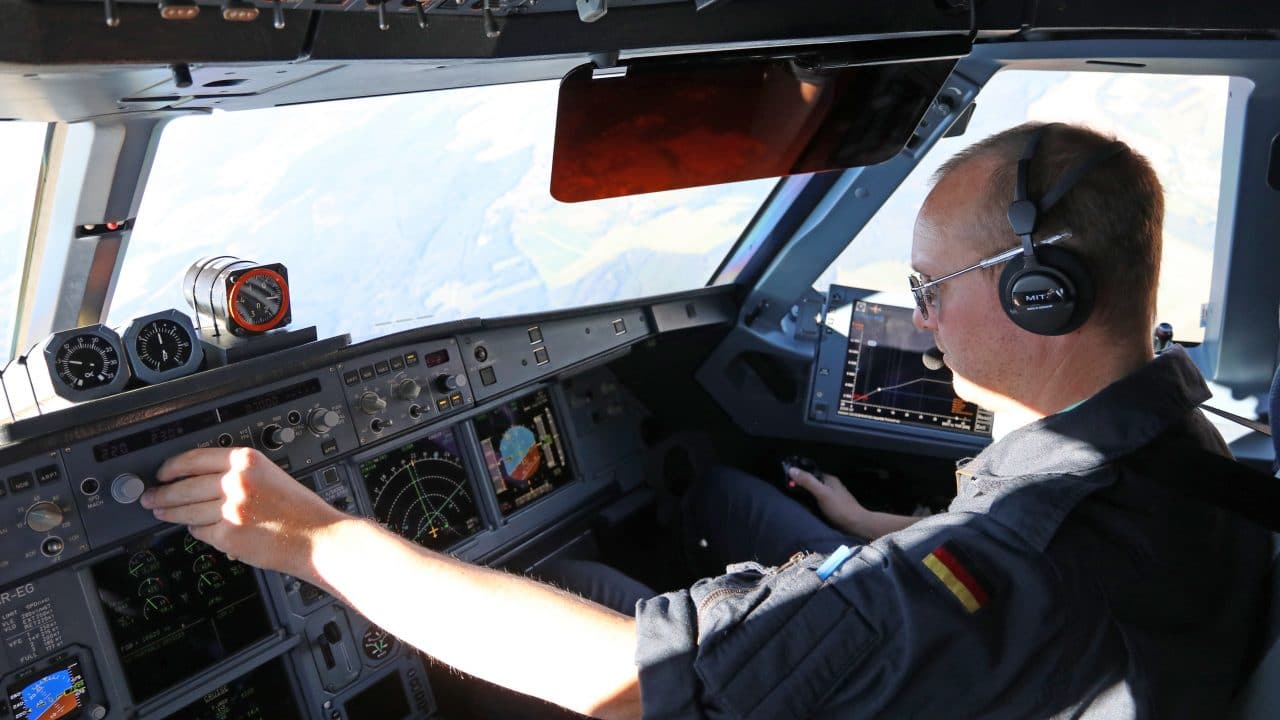
Residents near airports can tell you a thing or two about it – the deafening noise when planes take off or land whereby you can hardly hear a word outdoors. Although newer planes have already become somewhat quieter in recent years, at around 120 decibels during take-off and landing they are still loud enough to cause long-term damage to one’s hearing. For comparison: the crying of a baby peaks at 80 decibels, a jackhammer at 100, a rocket launch at 140 decibels.
Apart from the noise, the approach and landing of an aircraft are among the most labor-intensive phases of a flight for pilots. The German Aerospace Center (DLR) has developed the pilot assistance system LNAS (Low Noise Augmentation System) in order to “to support pilots as they perform the complex procedures required for a low-noise approach.” They can see on a display in the cockpit exactly when they have to perform which action so as to keep the noise level as low as possible.
For pilots, it is often difficult to pick the optimal time to deploy the flaps and to lower the landing gear in order to make that part of the landing as quiet and fuel-efficient as possible. The LNAS provides support. It shows exactly when they have to deploy the flaps, for example, in order to reduce noise and save kerosene.

Joint research with Swiss Sky Lab Foundation
In collaboration with the Swiss SkyLab Foundation and the Swiss Federal Laboratories for Materials Testing and Research (Empa), the DLR is testing the new system onboard the DLR A320 ATRA (Advanced Technology Research Aircraft) during approaches to Zurich Airport from 9 to 13 September 2019. For these test flights, the A320 ATRA has been equipped with a new high-precision algorithm and has another innovative system on board for Continuous Descent Approach (CDA).
A total of around 70 approaches will be carried out. “We need this many similar approaches so that we can get a broad spectrum of data on how the LNAS functions,” says Fethi Abdelmoula from the DLR Institute of Flight Systems. In addition to a group of scientists monitoring the functioning of the system, a DLR test pilot will also be present in the cockpit for safety reasons. According to DLR, the test flights are being conducted by 25 participating airline pilots in order to determine the practicality of the system.

First flight tests as early as 2016
As early as 2016, DLR conducted its first flight tests with a total of 74 approaches into Frankfurt Airport. At that time, scheduled pilots from four airlines made approach flights to Frankfurt – sometimes with the assistance system, sometimes without. “It has already become apparent that the principle of noise reduction works through more precise procedures when using flaps and landing gear during approaches,” said Prof. Klaus-Uwe Hahn at the time. He is head of the Flight Dynamics and Simulation Department at the DLR Institute of Flight Systems Technology. “The feedback from the pilots who flew the system was consistently positive. They found the assistance system to be extremely helpful, especially in difficult situations such as strong tailwinds or requests from air traffic control for higher speeds,” Even under the difficult conditions of peak periods at Frankfurt Airport, the approaches were up to more than one decibel quieter at maximum level. Kerosene consumption had fallen by ten percent compared to the final 25 miles of a an approach without use of the system.
For the new test flights seven noise measurement stations will be set up along the approach path which researchers from Empa’s Acoustics / Noise Reduction Department will use to record the overflights. In addition, the engine power, flap settings, airbrake position, and the landing gear deployment are all recorded during the approach. All the data collected is then analyzed using the sonAIR noise simulation program developed at Empa. The noise pollution caused by the flight is displayed on the computer for selected locations on the ground.
This data can then be used to generate detailed noise maps that accurately illustrate the differences to conventional approaches. “SonAIR was developed specifically for noise optimization during approach and take-off procedures,” says Jean-Marc Wunderli, Head of the Acoustics/Noise Reduction Laboratory at Empa. ”This joint project with DLR and SkyLab will give us the opportunity to compare noise pollution that is shown on our simulations with actual data from the existing seven measuring stations, and thereby double-check the accuracy of our calculations.”

Changing conditions
Conditions such as wind and aircraft weight, which change constantly, make an approach a very complex task for pilots. According to DLR test pilot Jens Heider, who sits in the cockpit of the A320 ATRA during the flight tests, an optimal energy balance during the approach is essential to be able to land as quietly as possible. “If the pilot carries out manoeuvres in accordance with these guidelines [from LNAS], the approach from cruising altitude down to the stabilization height 1000 feet above the ground can be carried out with minimum thrust, resulting in the lowest possible generation of noise and fuel consumption of,” Abdelmoula says summing up the advantages.
“The optimal scenario would be a descent with the engines at flight-idle, almost like a glider,” explains Martin Gerber, the Project Manager at SkyLab and the initiator for the further development of LNAS. “We want to use the assistance system for reducing the number of approaches that make suboptimal use of energy and provide pilots with the information they need for this purpose in an intuitive and comprehensible way.” Basic physical principles will not be altered, but the number of adverse acoustic effects from approaches could certainly be reduced.
The results of the flight tests in Zurich are expected in spring 2020. In the intervening period, LNAS is to be implemented into scheduled airline flights.
Here are more articles about the subject flying








